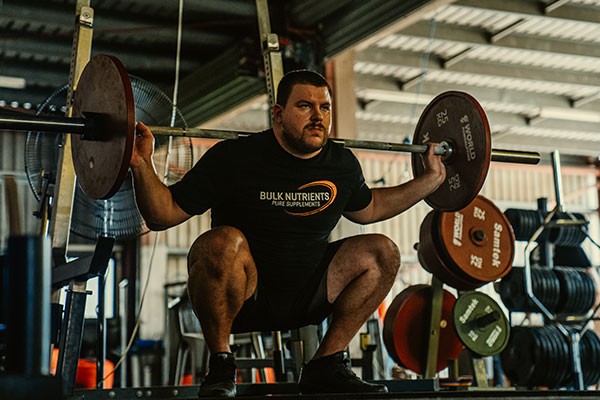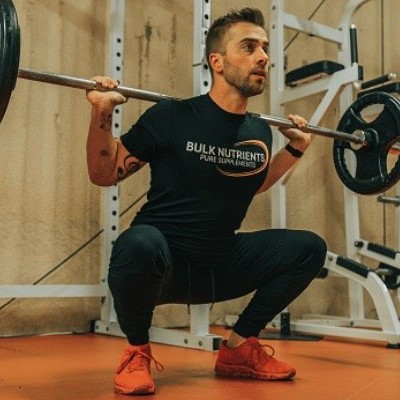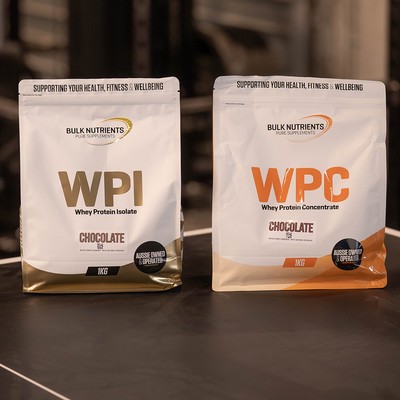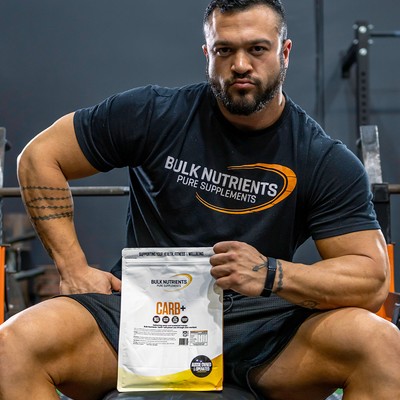Eight Tips to Help You Get a Bigger Squat

Develop a good mindset and harness your motivation
You need to find your drive and harness it. Ask yourself why it is that you want to squat 3, 4, 5 or 6 plates? What is it that’s going to get you back under the barbell when you’re thinking of skipping the gym, when you’ve let time get away from you – when it’s 11 pm and you still haven’t done your squat session, what’s going to get you there?
Set yourself realistic, incremental goals. If you’re squatting 110kg now and your end goal is 180kg, a 6-week program isn’t going to cut it.
My incremental goals were always set in 10kg lots, not only did this provide a measurable weight increase, but also a visual goal on the barbell. In the famous words of Dom Mazetti – “If you’re weight doesn’t look good, how do you expect to look good?”.
Work on getting your squat technique right
One of the major reasons for not breaking your squat plateau is an incorrect technique. The poor squat technique will take you so far, but as the load increases, weak areas will give way and form will deteriorate. For so many avid gym-goers, this is where the squat plateaus.
Squat depth is heavily discussed in the fitness community, usually based on concerns regarding knee and back injuries. Anatomically, our bodies are designed to be able to squat deeply and return to a standing position, so where does it all come undone?
Flexibility – particularly in the ankles and hips. Any limitation in the mobility of the ankle or hip will significantly impact the depth to which the squat can be performed safely. Where mobility is lacking, forces will transfer away from the immobile area to a corresponding joint.
For example, a lack of ankle flexibility will see the heels raise off the floor transferring more force to the knees.
A study has confirmed that pre-fatiguing the quadriceps significantly changes the squat technique from a squat to a stoop, placing extra pressure on a more rounded back to compensate for the fatigued quadriceps.
On the opposite side of the squat, a lack of hip mobility might result in a rounding of the back at the bottom of the squat, known as buttwinking, transferring force to the lower back. Neither situation provides a firm foundation for optimized, injury-free squats.
Muscle imbalances can also wreak havoc on technique. A great example is the knees collapsing in on the ascent out of the bottom of the squat, where the knees should be actively pushed out to ensure that they track over the toes.
A recent study was undertaken on skilled lifters to determine if lower limb and lumbopelvic mechanics changed when back squats were performed to failure. The major finding was as follows:
Whilst performing multiple sets to failure altered some joint kinetics, the comparable findings in joint range of motion suggest that technique was not altered. Therefore, skilled individuals appear to maintain technique when performing to failure.
This is exactly why the big squatters can keep squatting bigger, and poor technique will lead to plateaus and injuries.

Squat style and consistency (deep vs powerlifting)
The hotly debated deep squat versus powerlifting squat. I’m not here to weigh in on either or provide a how-to guide on squatting styles, but I do believe that each has its place.
The major difference between the two is bar placement. Placement of the bar high up on the traps allows the lifter to keep a slightly more upright torso, allowing a deeper squat. Whereas, the low placement of the bar on the traps pushes the torso forward more, reminiscent of a deadlift starting position, limiting the range of motion to just below parallel.
The important thing to note here is what kind of lift you are comfortable with because these aren’t interchangeable mid-set.
Given that the squat is one of the more complex movements you’ll perform in the gym, you want to practise one style over and over to ensure that the movement pattern is embedded.
Consistency is key here. The heavier the squat, the more your technique is tested and the bigger the consequences are if you’re doing it wrong. Having consistently good technique with submaximal lifts develops not only movement patterns but the musculature required to maintain stability under increasing loads.
This is the exact reason why someone who only leg presses will struggle with heavy squats. Whereas, squatting heavily has a significant transfer to leg press strength. This is a demonstration of skill transfer, and yes, squatting is a skill!
There’s a lot to say about squat depth and variation between individual biomechanics, particularly concerning limb lengths. I’m not going to go into this here.
Personally, I’ve always believed that the squat simply needs to get below parallel and that a deep squat should be the point where the body naturally stops descending while maintaining the correct posture (straight back, knees out, the bar in line with the midfoot, hamstrings laid on calves).

Get into a routine with your squat setup
Another thing that should remain consistent is your setup. Regardless of the weight, you’re squatting, be it the barbell only or a 1RM attempt, you should approach the squat the same way, every time.
Begin by visualising the lift, and walk through it step-by-step in your head. Approach the bar and get your hands in the correct placement. Duck your head under and ensure you are centred. Keep your upper body tight and unrack the barbell. Take a few steps backward. I find that I usually take 3 small steps and end up at the same distance from the rack every time.
Head slightly down, eyes forward. Contract your glutes in an isometric hold for 2-3 seconds. Take a deep breath and brace your core. Now squat!
If you're going for reps, don’t forget to breathe in between reps and re-brace your core before you go for the next rep.

Give yourself some constructive criticism when squatting heavy
Now is the most important time to be critical of yourself, and I’m not talking about how you snort when you laugh or how your calves are horrendously undersized (I feel you though!). I’m talking about your technique!
One of the hardest things to do when you making solid progress is to push your ego aside and be critical of your performance. You know that those last two reps had significant form degradation, but you ticked the box for reps, so add more weight next session, right? Wrong.
It’s a trap. Remember you’re developing a skill. You need to complete your reps with consistent technique if you want to progress long-term and avoid injuries. Stepping the weights back for a week or two is much less hampering to progress than plateauing for months or worse, an injury.

Get feedback on squats whenever possible
A good way to assess your squat progress is by filming yourself and watching it back or getting a coach or gym buddy to watch you squat. Watching back your squats can show technique breakdown or any fatal flaws, and provide visual feedback on performance from an angle that a coach might instruct from.
The video below was the beginning of my last program to work up to my goal, and regularly lifting weights in this range was more or less to mentally prepare me for the 2RM. For a little insight, by this stage, I was squatting 3 times a week, doing 8 sets of 3 reps with 165kg. Yes, that’s not a typo, 8 sets of 3 reps, 3 times a week. The video was taken as a self-assessment to look for technique breakdown of fatal flaws, and to provide me with visual feedback on my performance from an angle that a coach might instruct from.
In a study on the effectiveness of different forms of feedback on semi-professional rugby players undertaking loaded barbell back squats, the major finding was that all forms of feedback improved performance as compared to no feedback.

Choose squat accessories that work for you
Knee sleeves or knee wraps? Poly or leather belt? Weightlifting shoes or Chuck Taylors? The only important accessory to consider here is a barbell pad – and make sure you never use one!
A lot of accessory choices come down to your style of squat, be it the deep squat or powerlifting squat. Knee sleeves, poly belts and weightlifting shoes are more typical of an Olympic weightlifter who requires a significant amount of agility and flexibility to manipulate their body around the barbell at blistering speeds – think snatch and clean and jerk.
Whereas knee wraps, leather belts and Chuck Taylors are more typical of a powerlifter, who is looking to increase the rigidity of the entire movement over a single plane – down and back up! As a recreational lifter, the choice is really up to you.
Personally, I believe that knee sleeves/wraps and shoe choice offer little to no advantage, despite some evidence that weightlifting shoes may provide some advantages.
In saying that, as someone who enjoys the Olympic lifts, I wear knee sleeves and weightlifting shoes when I squat. For me, these provide the extra mental comfort of having warm, tight knees and a fraction more stability at the bottom of the squat due to foot positioning. They grew to become something that I can’t squat without because they are ingrained in my mindset and consistency.
Once the weights get big though, a weightlifting belt is a good investment. The choice of poly or leather is really a personal preference, as long as it is comfortable through the range of motion of the squat, its job is solely to provide extra intra-abdominal pressure.
This is not to say that every squat you perform should be belted though. My personal rule of thumb has always been that the belt goes on once the weights get beyond 1.5x bodyweight, and I got to this by trial and error.
Again, much of this comes down to providing a level of mental reinforcement for the movement you are about to perform.

Programming is crucial to making squat gains
This could be an entire blog in and of itself, so I’ll keep it brief. You need to program for the outcome that you want. If your goal is a 5x5 PB, then on your work up to a PB you need to be training 5x5.
The same applies to attempts at 1RM and even if you're aiming to PB the “will to live breaking” 20 rep squats.
Realise that this is a skill that you’re constantly developing and perfecting and that requires time. Also, realise that volume is required to perfect a skill, and programming is usually considered in 6-week blocks.
Don’t be afraid to change up your rep schemes between programs in fear of “losing progress”. In the year I seriously developed my squat, I had two programs of 20 rep squats, despite my goal to increase my 2RM. When I returned to programs of doubles and triples, I quickly recovered my previous bests and pushed through them by the end of the program.
Besides, anything feels easy after 20 rep squats! There is a direct relationship between muscle mass and squat strength, therefore, any way to break new muscle while practising the squat skill should remain on the cards.
Accessory exercises should focus on multi-joint exercises where possible. Good mornings, lunge variations and deadlift variations are all useful tools. Don’t skip on deadlifts just because your squatting – if squats are your priority, put squats first, then finish with deadlifts when you’re already gassed.
If you’re training legs once a week, that will need to change. You want to be squatting a minimum of two times per week and where possible, you should try and work your way up to squatting 3 times a week. I found 3 times a week to be the optimum, with all other training fitting around squatting.
I can appreciate that I am no athlete, nor a bodybuilder, and my squat goals pale in comparison to what either of these individuals squat.
However, what I’ve shared here are all the things I learned chasing my own goals. In the space of 12 months, I developed my squat from a poor form 130kg 1RM to 180kg 2RM with good form. I took a video of myself squatting 170kg for 2 reps, about 8 weeks before hitting my 180kg 2RM.
Whether the feedback is visual, by filming yourself to watch your technique or verbal, having a coach encouraging or critiquing your form, all forms of feedback can be useful in helping improve your performance.
Final thoughts on getting a bigger squat
A big squat is within everybody’s reach, but you need to level with yourself – you’re not going to get there in one program. It’s a testament to your dedication and at times, the sheer will to survive!
I’ve always believed that if you really want something, you’ll find a way to make it happen – squatting big is no different. There’s no satisfaction quite like standing up from your goal squat, so go and make that bar bend!
References:
- Brice, S. M., Doma, K., Harland, L. and Spratford, W. (2020) Impact of performing heavy loaded barbell back squats to volitional failure on lower limb and lumbo pelvis mechanics in skilled lifters. Sports Medicine and Biomechanics, 38(1), 100-105. DOI: 10.1080/02640414.2019.1683385
- Legg, H. S., Glaister, M., Cleather, D. J. and Goodwin, J. E. (2017) The effect of weightlifting shoes on the kinematics of the back squat. Journal of Sports Sciences, 35(5), 508-515. DOI: 10.1080/02640414.2016.1175652
- Rossi, F. E., Schoenfeld, B. J., Ocetnik, S., Young, J., Vigotsky, A. D., Contreras, B., Krieger, J., Miller, M. and Cholewa, J. (2016) Strength, body composition, and functional outcomes in the squat versus leg press exercise. The Journal of Sports Medicine and Physical Fitness, pISSN 0022-4707 - eISSN 1827-1928. DOI: 10.23736/S0022-4707.16.06698-6
- Trafimow, J. H., Schipplein, O. D., Novak, G. J. and Andersson, G. B. J. (1993) The effects of quadriceps fatigue on the technique of lifting. Spine, 18(3), 364-367. DOI: 10.1097/00007632-199303000-00011
- Weakley, J., Wilson, K., Till, K., Banyard, H., Dyson, J., Phibbs, P, Read, D. and Jones, B. (2018) show me, tell me, encourage me: the effect of different forms of feedback on resistance training performance. Journal of Strength and Conditioning Research, DOI: 10.1519/JSC.0000000000002887
- Ye, X., Loenneke, J. P., Fahs, C. A., Rossow, L. M., Thiebud, R. S., Kim, D., Bemben, M. G., and Abe, T. (2013) Relationship between lifting performance and skeletal muscle mass in elite powerlifters. The Journal of Sports Medicine and Physical Fitness, 53(4), 409-414.































